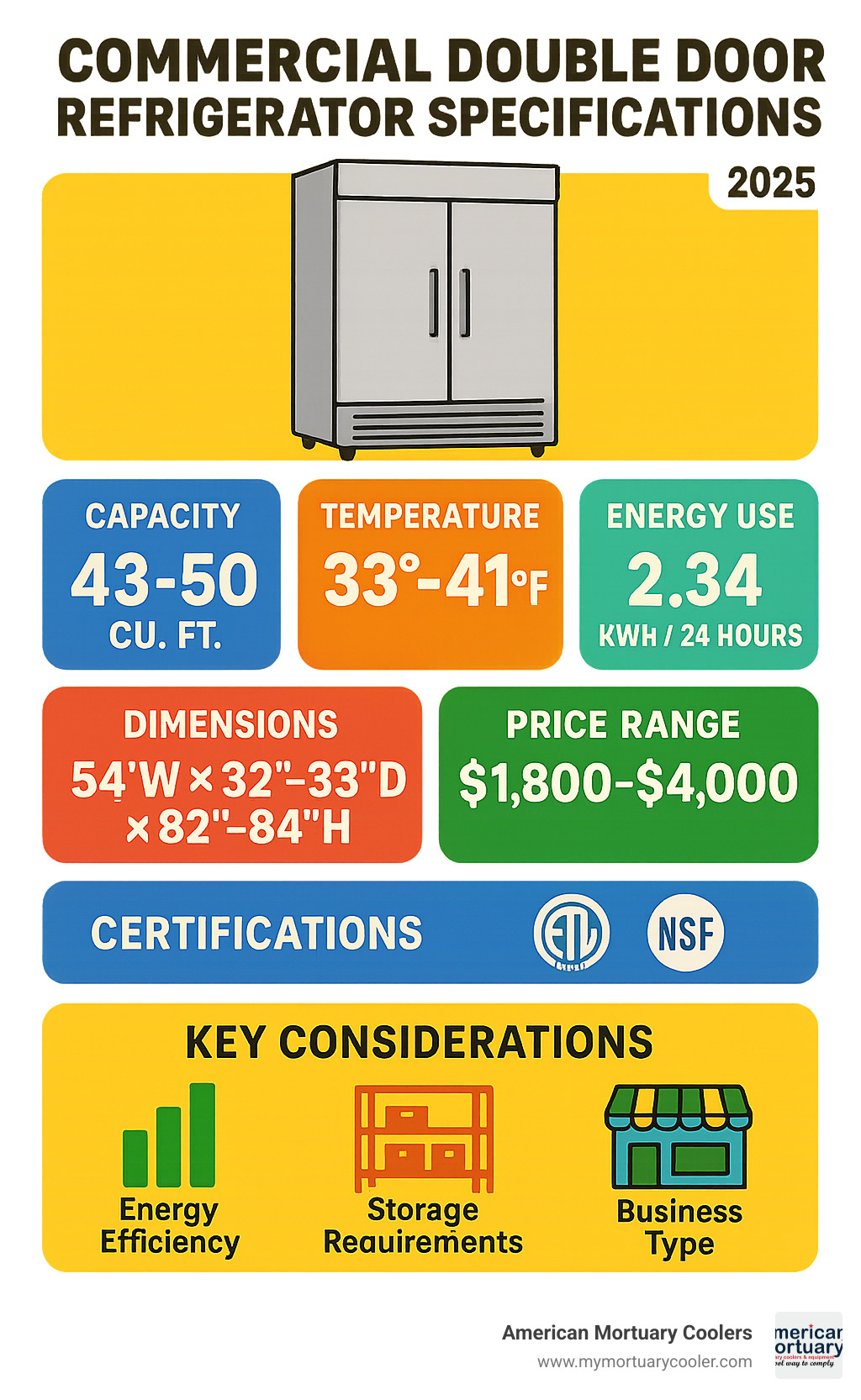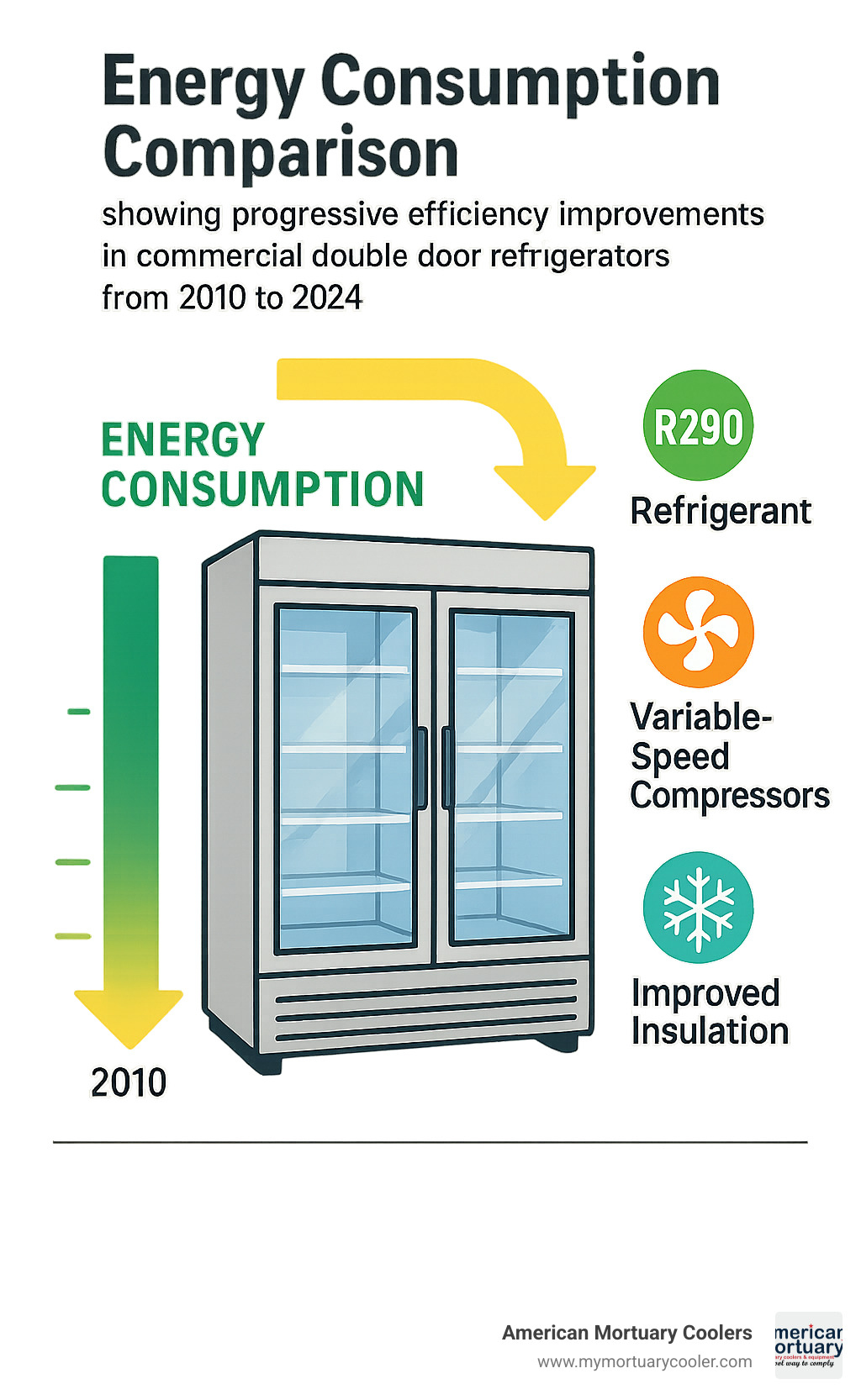Why Commercial Double Door Refrigerators Are Essential for Food Service Success
A commercial double door refrigerator is a two-door upright cooling unit designed for high-volume food storage in restaurants, cafes, and commercial kitchens.
Key Specifications:
- Capacity: 43-50 cubic feet typical storage
- Temperature Range: 33°F to 41°F (0.5°C to 5°C)
- Dimensions: Standard 54" wide × 32-33" deep × 82-84" high
- Energy Use: Approximately 2.34 kWh per 24 hours
- Price Range: $1,800 to $4,000 for new units
Main Benefits:
- Higher storage capacity than single-door units
- Better temperature control with dual-zone options
- Improved workflow with separate door access
- Energy savings up to 40% with R290 natural refrigerant
- Flexible shelving (typically 6 adjustable shelves)
Commercial kitchens rely on these units because they offer the perfect balance of storage capacity and energy efficiency. Most models maintain consistent temperatures through forced-air cooling systems and come with ETL and NSF certifications for food safety compliance.
I'm Mortuary Cooler, a national-level supplier specializing in commercial cooling solutions including commercial double door refrigerator systems for diverse industries. With years of experience helping businesses choose the right refrigeration equipment, I understand the critical role these units play in maintaining food safety and operational efficiency.

Key commercial double door refrigerator vocabulary:
How a Commercial Double Door Refrigerator Works & Why It Beats Single Door Units
A commercial double door refrigerator uses a forced-air cooling system that maintains the critical 33°F to 41°F range throughout the entire cabinet, unlike basic refrigerators that might have cold spots.
The cooling cycle relies on four key components: a robust compressor (usually 1/2 hp) that pressurizes refrigerant gas, a condenser that releases heat, an expansion valve managing refrigerant flow, and an evaporator that absorbs heat from inside the cabinet.
Most commercial double door refrigerator units mount their refrigeration systems on top, providing more storage space compared to bottom-mounted alternatives. Higher-capacity units often feature dual-compressor setups for redundancy.
Commercial units excel with 2¼" to 4" of foamed-in insulation - significantly thicker than residential units. This superior insulation maintains consistent temperatures while keeping energy bills reasonable.
Commercial double door refrigerator vs. single & walk-in
A commercial double door refrigerator offers the ideal balance - 43-50 cubic feet of storage in a 54" × 33" footprint. Single door units typically max out around 23-27 cubic feet, requiring double the floor space for equivalent storage.
Walk-in coolers offer massive capacity but require serious floor space and budget commitment. Double door units provide superior traffic flow - staff can access one side without opening the entire unit, maintaining efficiency.
Commercial double door refrigerator temperature science
Top-mounted evaporators create superior air circulation compared to side-mounted alternatives. R290 refrigerant delivers up to 40% energy savings compared to traditional refrigerants while having zero ozone depletion potential.
Scientific research on natural refrigerants confirms R290 offers excellent thermodynamic properties and faster cooling recovery times during busy service periods. Variable fan systems adjust speed based on temperature needs, saving energy during quieter periods.
Types & Sizes: Finding the Right Fit
Choosing the right commercial double door refrigerator becomes easier when you understand the main categories:
Reach-in models dominate commercial kitchens with 43-50 cubic feet of storage, perfect for prep areas requiring quick ingredient access.
Display merchandiser units combine refrigeration with marketing using LED lighting to showcase beverages, desserts, or grab-and-go items.
Undercounter models offer 30-35 cubic feet while tucking beneath prep surfaces, solving space constraints.
Chef-base models provide refrigerated storage below with work surfaces on top - ideal for pizza shops and sandwich prep.
Walk-in double door coolers use modular panel construction starting at 6' × 6' configurations.
Mobile units feature heavy-duty 4-inch casters with brake systems for flexible positioning.
Standard dimensions: 54" wide × 32-33" deep × 82-84" high.
Reach-In & Undercounter Explained
Reach-in models feature pan slides accommodating standard food service containers, self-closing doors with 90° hold-open capability, and ergonomic design with no-stoop lower shelves.
Undercounter models maximize kitchen real estate while providing convenient access to frequently used items.
More info about reach-in models covers additional considerations.
Display & Merchandiser Variants
Display models use LED lighting and glass doors (swing or sliding) to boost impulse sales up to 30%. Features include self-closing doors with security locks and digital temperature displays for customer confidence.
Walk-In Double Door Coolers
Walk-in configurations use modular panels with 4-inch thick insulation exceeding EISA standards. Remote compressor options reduce kitchen heat loads. Standard door sizes: 35½" × 78".
More info about walk-ins provides detailed sizing guidance.
Key Features Checklist Before You Buy
Focus on these essential features when shopping for a commercial double door refrigerator:
Energy Star certification reduces energy use by 15-20%, paying for itself through utility savings.
R290 eco-friendly refrigerant can slash energy consumption by up to 40% while being environmentally sustainable.
Digital controllers offer programmable defrost cycles and diagnostic capabilities with clear error codes.
Shelving load capacity should handle 75-100 pounds per shelf when properly loaded.
Self-closing doors with magnetic gaskets and 90° hold-open features are essential for busy kitchens.
Warranty coverage typically includes 1-2 years parts/labor plus 5-6 years compressor coverage.
Glass vs. Solid: Which Double Door Is Right?
Glass doors provide excellent product visibility, boosting impulse sales by up to 30%. Staff can monitor inventory without opening doors, saving energy. They work well in customer-facing environments and include LED lighting integration.
Solid doors offer superior insulation (15-20% better thermal performance), lower upfront costs, and better security since contents aren't visible. They provide better humidity control in steamy kitchen environments.
Energy efficiency favors solid doors due to thicker construction and lack of thermal bridging. Marketing benefits favor glass doors for showcasing products.
More info about 2-door glass fridges covers additional selection considerations.
Installation & Maintenance Essentials
Proper clearances require 6" on all sides and 12" top clearance for optimal performance. Electrical requirements typically call for 115V/60Hz/1Ph power.
Regular condenser cleaning (monthly in normal environments, weekly in high-dust areas) prevents 25-30% energy consumption increases. Gasket maintenance prevents costly air leaks.
Remote monitoring systems alert staff to problems before disasters occur, especially valuable for preventing off-hours food loss.
Brands, Models, Prices & Emerging Trends
Key manufacturers offer different strengths:
Avantco delivers reliable performance with their A-49R-HC model (47 cubic feet, R290 refrigerant).
Migali focuses on energy efficiency with C-2R series featuring smart variable fan systems.
SABA provides impressive warranty coverage (2 years parts/labor, 5 years compressor) with nationwide service.
True specializes in merchandising units with crystal-clear glass doors.
Polar and Williams bring European engineering with solid construction.
Most units offer 30-50 cubic feet capacity with 6 adjustable shelves. Smart technology now includes IoT controls for remote monitoring and energy tracking.
| Model | Capacity | Price Range | Warranty | Energy Use | Refrigerant |
|---|---|---|---|---|---|
| Avantco A-49R-HC | 47 cu ft | $2,200-2,800 | 1yr/5yr comp | 516W | R290 |
| Migali C-2R | 49 cu ft | $2,800-3,400 | 2yr/5yr comp | 2.34 kWh/24h | R290 |
| SABA S-47R | 47 cu ft | $3,200-3,800 | 2yr/5yr comp | 4.56A @ 115V | R134a |
Latest Innovations in Commercial Double Door Refrigerator Technology
Variable-speed fans adjust based on cooling needs, cutting energy consumption by 15-25%. Touch-screen controls provide intuitive interfaces with programmable settings and multilingual displays.
Predictive maintenance uses sensors to monitor performance and predict component failures. Carbon-neutral refrigerants like R290 and R744 deliver excellent performance with minimal environmental impact.
Antimicrobial handles with copper-infused surfaces naturally inhibit bacterial growth.

Buying New, Refurbished or Renting
Buying new costs $1,800-4,000 with full warranties and latest technology. Refurbished units save 40-50% with quality refurbishment including professional cleaning and component testing.
Rent-try-buy programs offer flexibility, crediting 60% of rental payments toward purchase. Tax advantages include Section 179 deductions for purchases or fully deductible rental payments.
Lifecycle ROI often favors energy-efficient models despite higher upfront costs - R290 units might cost $500 more but save $200-400 annually in energy costs.
Safety, Certifications & Regulatory Must-Haves
Safety certifications protect against violations and equipment failures:
NSF-7 certification ensures strict sanitation requirements are met - required by most health departments.
ETL listing covers electrical safety with both ETL electrical and ETL sanitation marks needed.
Energy Star certification proves efficiency standards while potentially qualifying for utility rebates (15-20% energy savings).
SNAP rules from EPA govern acceptable refrigerants. Modern units using R290, R134a, or R404A meet current regulations.
Check local health codes for additional requirements like temperature monitoring equipment or placement restrictions.
Compliance checklist for a commercial double door refrigerator
Label verification - ensure all certification labels are visible and readable.
Record keeping - temperature checks every four hours with logs available for inspection.
Employee training - staff should understand temperature monitoring, cleaning requirements, and emergency procedures.
Keep organized: installation records, maintenance schedules, temperature logs, cleaning procedures, and emergency contacts.
Frequently Asked Questions about Commercial Double Door Refrigerators
What is the standard temperature range for a commercial double door refrigerator?
Your commercial double door refrigerator should maintain 33°F to 41°F (0.5°C to 5°C). Most units operate between 35°F and 38°F during normal operation.
Digital controllers allow fine-tuning in 1-degree increments, with premium models offering dual-zone capability. Consistent temperature control extends product shelf life and reduces waste.
How often should condenser coils be cleaned?
Monthly cleaning for normal environments, weekly for high-dust areas like bakeries. Dirty coils increase energy consumption by 25-30% and cause premature compressor failure.
Shut down the unit first, remove protective panels, and use specialized brushes or compressed air. Never use water on electrical components.
Can I convert my solid door unit to glass doors later?
Conversion requires new door assemblies, modified hinges, updated gaskets, and lighting installation - typically costing 60-80% of a new glass door unit.
Converted units rarely perform as well as purpose-built glass door models. Buy glass doors from the start if you think you'll want them - they boost impulse sales by up to 30% in retail environments.
Conclusion
Choosing the right commercial double door refrigerator centers on balancing storage capacity with energy efficiency. Models with R290 refrigerant and Energy Star certification deliver real utility savings while meeting environmental standards.
Future-proof cooling means investing in digital controls, predictive maintenance systems, and eco-friendly refrigerants. These features cost more upfront but pay for themselves through lower operating costs and regulatory compliance.
Prioritize robust warranties and established service networks. Quality commercial units deliver 10-15 years of reliable service with proper maintenance - monthly condenser cleaning and correct installation are essential.
For businesses requiring specialized cooling solutions beyond standard models, American Mortuary Coolers brings decades of experience in custom refrigeration systems. While we specialize in mortuary cooling, our precision temperature control expertise extends to various industries with unique requirements.
Whether you choose a reach-in model for prep work, glass-door merchandiser for sales, or custom configuration, quality refrigeration equipment is an investment in your business's future. Better equipment means improved food safety, lower energy costs, and reliable operation.
More info about cooler sizes helps determine the perfect capacity for your specific needs.
By choosing equipment that serves both current needs and future growth, you're making a decision that will support your success for years to come.
















